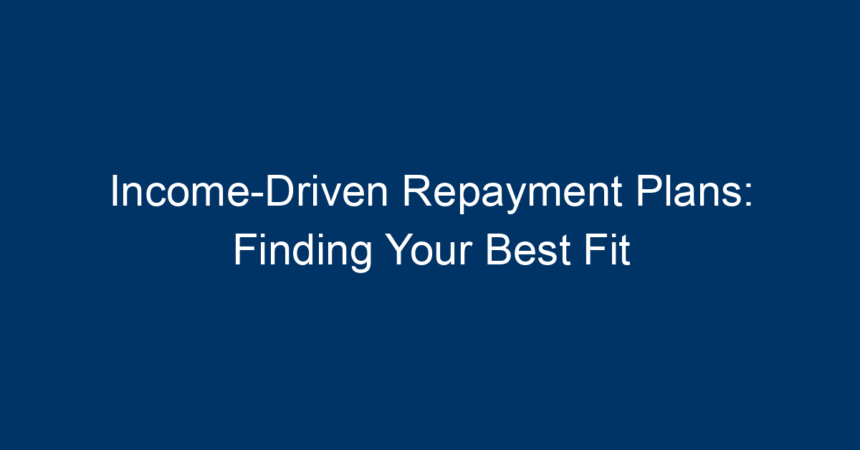Managing student loan debt can feel overwhelming, especially with the rising costs of education. Fortunately, income-driven repayment plans offer borrowers a way to better manage their payments based on their income and family size. In this article, we’ll explore what income-driven repayment plans are, the different types available, and how you can determine the best option for your financial situation.
What Are Income-Driven Repayment Plans?
Income-driven repayment plans are designed to make student loan payments more manageable for borrowers who have a limited income. These plans adjust monthly payments according to your discretionary income, helping reduce financial strain. The primary goal is to provide borrowers with a path to repayment that aligns with their ability to pay, ultimately making student loans less burdensome.
Benefits of Income-Driven Repayment Plans
-
Lower Monthly Payments: By basing your payment on your income, you may find yourself paying significantly less than under a standard repayment plan.
-
Forgiveness Opportunities: Many income-driven repayment plans offer forgiveness of any remaining balance after 20 or 25 years of qualifying payments, depending on the plan.
-
Protection Against Financial Hardship: If your income decreases or your family size changes, your payments can be recalculated, providing a safety net in tough times.
- Potential for Tax Benefits: Depending on your financial situation and state of residence, the interest you pay on your student loans may be tax-deductible.
Types of Income-Driven Repayment Plans
Understanding the various income-driven repayment plans available is crucial for choosing the right one for your circumstances. Here are the main types:
1. Income-Based Repayment (IBR)
IBR plans limit your monthly payments to a percentage of your discretionary income. Here are some key points:
-
Payment Calculation: If you’re a new borrower after July 1, 2014, your payments are capped at 10% of your discretionary income. For others, the cap is 15%.
- Forgiveness: After 20 years of qualifying payments, your remaining loan balance may be forgiven.
2. Pay As You Earn (PAYE)
PAYE is designed for newer borrowers and has similar features to IBR but more favorable terms.
-
Payment Calculation: Payments are limited to 10% of your discretionary income.
- Forgiveness: After 20 years of qualifying payments, any remaining balance may be forgiven.
3. Revised Pay As You Earn (REPAYE)
REPAYE extends benefits to a wider range of borrowers and includes some unique features.
-
Payment Calculation: Payments are capped at 10% of your discretionary income, similar to PAYE and IBR.
- Forgiveness: For undergraduate loans, forgiveness occurs after 20 years, while for graduate loans, the timeline extends to 25 years.
4. Income-Contingent Repayment (ICR)
ICR is available to federal student loan borrowers, providing even more flexibility.
-
Payment Calculation: Your monthly payment is the lesser of 20% of your discretionary income or what you would pay on a fixed payment over 12 years.
- Forgiveness: Remaining balances after 25 years may be eligible for forgiveness.
How to Decide Which Income-Driven Repayment Plan is Right for You
Selecting the right income-driven repayment plan involves assessing your financial situation and understanding each plan’s terms. Here’s a step-by-step process to help you make an informed decision:
Step 1: Assess Your Current Income
Begin by evaluating your current financial situation. Gather documentation of your income, expenses, and family size. This information will be essential for calculating your discretionary income, which is the basis for your repayment plan.
Step 2: Compare the Plans
Once you have your financial details, compare the terms of each income-driven repayment plan.
-
IBR vs. PAYE: If you qualify for both, consider how long you plan to be in repayment and whether you expect changes in your income.
- REPAYE: This plan may be more favorable if you anticipate a lower income over the long term or if you plan to pursue a career in public service.
Step 3: Utilize Online Calculators
Many student loan servicers and financial websites offer online calculators to help you estimate your monthly payments under different plans. Use these tools to visualize how each plan affects your budget over time.
Step 4: Consult with Financial Advisors or Loan Servicers
Don’t hesitate to reach out to financial advisors or your loan servicer to gain clarity on the options available to you. They can offer personalized insights based on your specific situation.
Step 5: Analyze Your Long-Term Goals
Consider your long-term financial goals. If you anticipate substantial career growth, a plan with loan forgiveness might be beneficial. Alternatively, if your income is stable and you plan on paying off your loans sooner, a standard repayment plan may work better.
Additional Considerations for Income-Driven Repayment Plans
Reporting Income
One crucial aspect of income-driven repayment plans is the requirement to annually recertify your income. Failing to do so can result in your payments reverting to the standard amount, which can be significantly higher.
Impact on Credit Score
While income-driven repayment plans can alleviate immediate financial stress, they may have implications for your credit score if you miss payments or default. Make sure to stay engaged with your loan servicer and monitor your credit report.
Public Service Loan Forgiveness
If you’re working in public service, consider how income-driven repayment plans align with the Public Service Loan Forgiveness (PSLF) program. Under PSLF, loans may be forgiven after 10 years of qualifying payments, providing an excellent opportunity for eligible borrowers.
Conclusion: Finding the Right Fit for Your Finances
Income-driven repayment plans can be a lifeline for many borrowers struggling with student debt. By carefully considering your income, long-term goals, and the specific terms of each plan, you can find the best fit for your needs.
Actionable Insights
-
Gather Your Financial Documents: Start by collecting information about your income, expenses, and family size.
-
Utilize Online Tools: Use online calculators to estimate payments under different plans.
-
Consult with Experts: Don’t hesitate to consult financial advisors or student loan servicers for tailored advice.
- Stay Proactive: Keep track of your plan’s requirements, especially regarding annual income recertification.
With the right information and proactive planning, you can navigate the complexities of student loan repayment and find a solution that fits your lifestyle and financial goals. Don’t let student loans define your financial future; take charge today with these income-driven repayment plans!




